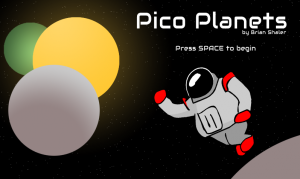Until Friday night, I had never heard of Ludum Dare, a global game development event celebrating its 10th anniversary. I found it via Reddit or Hacker News or Twitter or something, and discovered the event had kicked off 4 hours prior. Everyone participating in the Compo was given 48 hours to create a game from scratch around a theme announced that night. An alternate Jam competition has more relaxed rules, allowed teams, and ran for 72 hours. The theme was “Tiny Worlds,” which can be tricky when coming up with a compelling game idea. Fortunately, the theme and rules allow for pretty broad interpretation.
I wasn’t sure I would participate, but an idea popped into my head. Inspired in part by a segment of Dragon Ball Z Kai, I pondered what it would be like to jump from tiny planet to tiny planet. Mainly, what would happen to your perspective of “up” and “down” if you jump from the top of one planet to the bottom of another? The concept of “down” essentially just means “in the direction of the pull of gravity.” What drove me to want to build the game was the idea of making a 2D platformer where the directions up, down, left, and right are completely fluid and based on the gravitational pull of planets around the character.
Even though I haven’t used CoffeeScript or Processing.js before, I decided to try them out. Probably not a good idea on such a short timeline, but oh well.
The result was an auto-orienting 2D puzzle game where you have to jump from tiny planet to tiny planet to get to your goal before your oxygen runs out. You can walk around on planets and jump, but after leaving a planet’s surface, there is no longer any control over the character. That means if you miss a planet, you can drift off into space forever!
I finished an hour before the deadline and set up the game at PicoPlanets.com (a play on “pico” meaning one one-millionth, or 0.000001) and made the source code available on GitHub. You can also see screenshots and blog posts about the progress (“making of”) here on my Ludum Dare author page.



